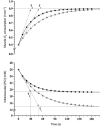Effects of prior exercise on oxygen uptake and phosphocreatine kinetics during high-intensity knee-extension exercise in humans
- PMID: 11711581
- PMCID: PMC2278929
- DOI: 10.1111/j.1469-7793.2001.0291k.x
Effects of prior exercise on oxygen uptake and phosphocreatine kinetics during high-intensity knee-extension exercise in humans
Abstract
1. A prior bout of high-intensity square-wave exercise can increase the temporal adaptation of pulmonary oxygen uptake (.V(O2)) to a subsequent bout of high-intensity exercise. The mechanisms controlling this adaptation, however, are poorly understood. 2. We therefore determined the dynamics of intramuscular [phosphocreatine] ([PCr]) simultaneously with those of .V(O2) in seven males who performed two consecutive bouts of high-intensity square-wave, knee-extensor exercise in the prone position for 6 min with a 6 min rest interval. A magnetic resonance spectroscopy (MRS) transmit-receive surface coil under the quadriceps muscle allowed estimation of [PCr]; .V(O2) was measured breath-by-breath using a custom-designed turbine and a mass spectrometer system. 3. The .V(O2) kinetics of the second exercise bout were altered compared with the first such that (a) not only was the instantaneous rate of .V(O2) change (at a given level of .V(O2)) greater but the phase II tau was also reduced - averaging 46.6 +/- 6.0 s (bout 1) and 40.7 +/- 8.4 s (bout 2) (mean +/- S.D.) and (b) the magnitude of the later slow component was reduced. 4. This was associated with a reduction of, on average, 16.1% in the total exercise-induced [PCr] decrement over the 6 min of the exercise, of which 4.0% was due to a reduction in the slow component of [PCr]. There was no discernable alteration in the initial rate of [PCr] change. The prior exercise, therefore, changed the multi-compartment behaviour towards that of functionally first-order dynamics. 5. These observations demonstrate that the .V(O2) responses relative to the work rate input for high-intensity exercise are non-linear, as are, it appears, the putative phosphate-linked controllers for which [PCr] serves as a surrogate.
Figures





 (at a given
(at a given  , β
, β ) is significantly increased from the first to the second bout of repeated high-intensity exercise in seven subjects. B, as a result of the unchanged steady-state amplitude of
) is significantly increased from the first to the second bout of repeated high-intensity exercise in seven subjects. B, as a result of the unchanged steady-state amplitude of  in the two repeats, the time constant (τ) is also significantly reduced.
in the two repeats, the time constant (τ) is also significantly reduced.

References
-
- Barstow TJ, Buchthal S, Zanconato S, Cooper DM. Muscle energetics and pulmonary oxygen uptake kinetics during moderate exercise. Journal of Applied Physiology. 1994;77:1742–1749. - PubMed
-
- Barstow TJ, Jones AM, Nguyen PH, Casaburi R. Influence of muscle fibre type and pedal frequency on oxygen uptake kinetics of heavy exercise. Journal of Applied Physiology. 1996;81:1642–1650. - PubMed
-
- Barstow TJ, Lamarra N, Whipp BJ. Modulation of muscle and pulmonary O2 uptakes by circulatory dynamics during exercise. Journal of Applied Physiology. 1990;68:979–989. - PubMed
-
- Barstow TJ, Molé PA. Linear and non-linear characteristics of oxygen uptake kinetics during heavy exercise. Journal of Applied Physiology. 1991;71:2099–2106. - PubMed
Publication types
MeSH terms
Substances
LinkOut - more resources
Full Text Sources
Medical

